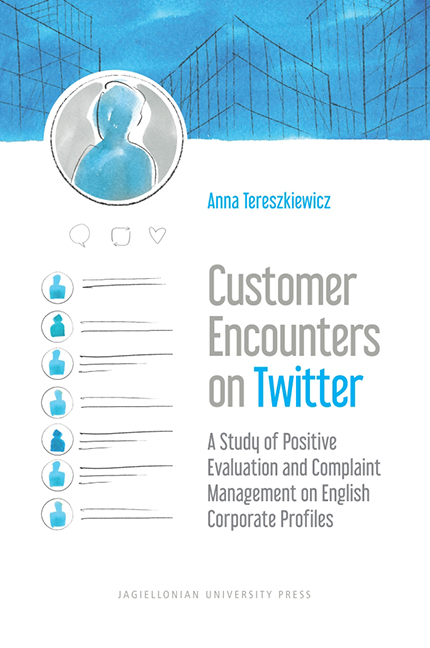 Customer Encounters on Twitter
Customer Encounters on Twitter Book contents
- Frontmatter
- Table of Contents
- Acknowledgements
- Introduction
- Chapter 1 Social media and corporate communication
- Chapter 2 Customer encounters as a genre of social interaction
- Chapter 3 Corporate profiles on Twitter – general characteristics
- Chapter 4 Positive evaluation and complaint management on Twitter
- Chapter 5 Selected politeness and lexicogrammatical properties of the tweets
- Conclusions
- References
Chapter 3 - Corporate profiles on Twitter – general characteristics
Published online by Cambridge University Press: 09 February 2022
- Frontmatter
- Table of Contents
- Acknowledgements
- Introduction
- Chapter 1 Social media and corporate communication
- Chapter 2 Customer encounters as a genre of social interaction
- Chapter 3 Corporate profiles on Twitter – general characteristics
- Chapter 4 Positive evaluation and complaint management on Twitter
- Chapter 5 Selected politeness and lexicogrammatical properties of the tweets
- Conclusions
- References
Summary
Company profiles – structure and types of posts
As indicated above, Twitter allows users to create individual profiles by means of a number of affordances, comprising visual and text-based means of communication.
The component parts of the profiles comprise profile data, a background image, a thumbnail image, a bio and a list of posts. All of these serve as important image management tools which allow the company to create and project a desired identity.
a) Profile data
Profile information comprises the data concerning the number of posts, followers, followees, likes, lists and moments. The data may have a significant persuasive potential, as they reflect the company's activity, degree of responsiveness and popularity.
b) Background images
Background images represent different degrees of complexity, comprising only text-based forms or highly multimodal, image- and text-based shapes. Background images may present company products, services, the company's logo and brand name, as well as advertising slogans and messages. The images may refer to recent advertising campaigns and as such may serve additional promotional purposes.
c) Thumbnail images
Thumbnail images in corporate profiles, in contrast to background images, tend to have a simpler form. The images most frequently involve the company's logo or the company's name.
d) Bios
Bios assume different forms and include short basic information concerning the profile, its purpose and content. The notes may also provide information on the company's location, company's website address, the date when the company joined Twitter, as well as links to multimedia content posted on the profile.
In their bios, most companies clearly state the function of the profile, i.e. presentation of news concerning the company and/or customer service. Bios are structured differently, with a more information-oriented form, as exemplified in (1), where the note includes plain statements of the two purposes of the profile, or a more information- and promotion-oriented form, as exemplified in (2). In such bios, companies promote the company and the profile, introduce and advertise new products, and encourage consumers to check the company's offer.
- Type
- Chapter
- Information
- Customer Encounters on TwitterA Study of Positive Evaluation and Complaint Management on English Corporate Profiles, pp. 77 - 88Publisher: Jagiellonian University PressPrint publication year: 2022


